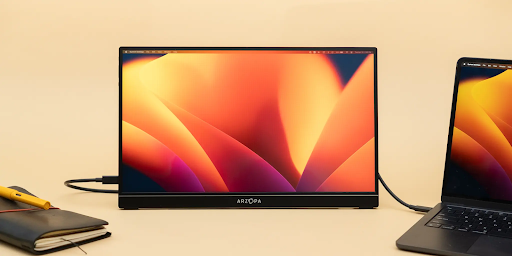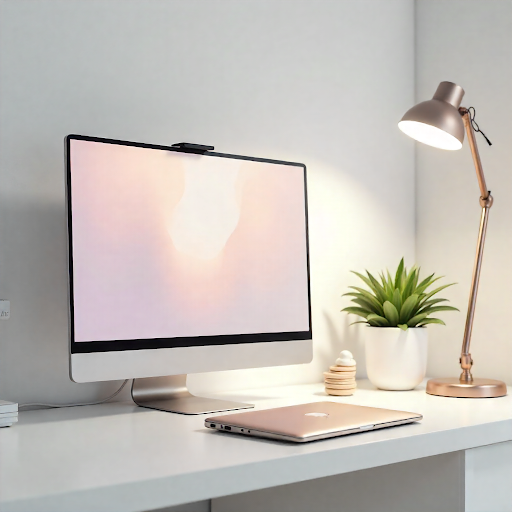The way we work, create, and play has changed significantly over the past few years, and MacBook owners are no exception. Digital nomads, remote workers, and people who simply love the freedom and flexibility of the MacBook lifestyle are finding more and more opportunities to bring their computers with them, whether that’s out in nature or from one side of the globe to the other.
Digital creators who are constantly editing on the go, programmers with long nights of coding ahead of them, and business professionals who want to show off presentations without relying on a projector all have a lot in common.
All these people can benefit greatly from a portable 23 inch computer monitor.
Portable monitors are designed to be lightweight, easy to set up, and work with virtually any laptop or computer. Unlike a regular desktop monitor, they are slim and easily transportable.
Connecting a portable monitor to a MacBook is a simple way to extend your MacBook screen and increase your productivity levels, but before purchasing one, you’ll want to know exactly what to expect.
In this post, we cover everything about connecting a portable 23-inch monitor to a MacBook. We’ll discuss the benefits, types of connectivity, and configuration.
Should I Get a Portable Monitor for My MacBook?
A portable 23 inch computer monitor for MacBook can benefit many people, from digital nomads to people who just need more screen real estate for their daily work. Working with only the built-in MacBook display is a unique experience, but that limited screen space starts to become a problem the more things you need to do on your computer, whether that’s browsing tabs or working on multiple windows side by side.
A MacBook with a 13-inch or 14-inch screen is highly portable and great for taking your work on the go, but if you work with complex documents, designs, or spreadsheets, you’ll find yourself resizing windows constantly to make everything fit. In these cases, a 23-inch screen makes more sense for MacBook users.
If you want a large display that’s both high-quality and easy to transport, then a 23-inch portable monitor is a great way to go. It gives you desktop-like screen space while remaining compact enough to throw in a backpack and take anywhere.
What to Expect When Connecting a Portable Monitor to a MacBook
macOS is designed to detect and use any external display that you plug into it, so the process of setting up a portable monitor is a straightforward one, but here are some things you’ll want to know:
Connection Options
Most portable monitors have USB-C ports that use DisplayPort Alt Mode, so they’re ready to connect to a MacBook or any other computer with USB-C ports. If you have a MacBook Air or Pro (2016 and newer), all you need is a USB-C cable to connect your portable monitor to your Mac.
Older MacBooks that use the Thunderbolt 1 or Thunderbolt 2 standards may require adapters to connect your portable monitor, such as a USB-C to HDMI adapter. Check that your portable monitor and MacBook are compatible before buying.
Power Sources
Most portable 23-inch monitors will be powered by your MacBook. The downside is that some larger portable displays, particularly those with 4K or higher resolutions, might not be able to draw enough power from your Mac through one USB-C port.
A 23-inch display is much larger than a typical 13-inch or 15-inch portable monitor, so it may come with a power adapter to plug into a wall outlet or need to be connected through a second USB-C cable. When looking at portable monitors, check their power requirements before buying.
Plug and Play
Once you connect your portable monitor, you’re ready to go! Simply choose “Detect Displays” in the “Displays” section of System Settings. You’ll see options to adjust your display resolution, brightness, and scaling factor.
Adjusting Your Monitor Settings
You can extend your desktop and use your portable monitor for extra workspace, or you can choose “Mirror” to make the display show exactly what’s on your MacBook screen. The latter is generally used for presentations, so for productivity purposes, extending the screen is the way to go.
You can also adjust the resolution and scaling factors. A higher-resolution portable 4K monitor will allow you to take advantage of macOS’s Retina scaling, which means crispier visuals. However, if you want to see larger text and icons, you can reduce the scaling factor.
Finally, calibrate your portable display using the same display calibration tool found in the “Displays” section of System Settings.
Benefits of Using a Portable Monitor With MacBook
The dual monitor setup with MacBook has endless benefits. It makes multitasking easier and creates an efficient working space that can rival even desktop computers in productivity.
Benefits include:
Seamless multitasking
You can keep your primary work on your MacBook screen while using your portable display for web pages, chat apps, and more. You’ll switch less between windows and tabs and focus more on your actual work.
Enhanced creative workflows
Video editors, photographers, and graphic designers can have one screen for previewing content and another for editing, and benefit from the extra screen space.
Gaming and streaming on a larger display
macOS can run some great games, and if you’re a gamer, a larger portable monitor will give you a more immersive gaming experience. The same goes for movies and streaming services, especially with a 4K screen.
Portable monitor setups offer the ultimate flexibility for remote work
Remote work often requires different settings, from the home office to the local coffee shop to travel. A lightweight 23-inch monitor gives you the power and performance of a dual-screen workstation from virtually anywhere.
Performance Expectations
Portability doesn’t mean that you have to give up on quality. Here are some things you should expect from a larger portable monitor.
Resolution
While many portable monitors come with Full HD (1920×1080) resolution, some models are capable of 4K (3840×2160) resolutions, which is great for MacBook owners who want stunning clarity on their secondary screen.
Color gamut and HDR
MacBooks feature Retina displays with impressive color and dynamic range, and many of the more premium portable monitor models now feature wide color gamuts (sRGB, AdobeRGB) and HDR support, which means vibrant, high-quality visuals.
Touchscreen options
MacBooks don’t have touchscreen displays, but you can add one! Many portable monitors feature touchscreen capabilities that MacBook users can benefit from. Touchscreens can be useful for presentations or drawing, although macOS doesn’t natively support using touch controls with your MacBook.
Refresh rates and response times
Gamers will also want to look for displays with higher refresh rates or low response times, which makes motion smoother and more responsive. Portable monitors are generally more limited in these specifications than larger, desktop displays, so if you’re looking for a portable 120Hz screen or something with low response times, your best bet is to shop with that in mind.

Factors to Consider Before Buying a Portable Monitor
A good portable monitor is an investment, so before you go shopping, make sure to consider the following things:
Weight
23 inches gives you a lot of screen real estate, but it also means your monitor will be slightly heavier than a 15-inch or 17-inch portable monitor. If portability is the number one factor for you, check the weight and thickness of the portable display before buying.
Build quality
Portable monitors are often thrown into bags, backpacks, and checked baggage. You want one with a rigid frame, scratch-resistant screen, and a cover or case that protects it.
Connectivity
Not every portable monitor has USB-C, HDMI, and headphone jacks, so make sure you choose one with multiple ports and can connect it to other devices besides your MacBook.
Stand or mounting
Portable monitors usually come with a foldable stand, but some have magnetic covers that also double as a stand. If you plan to use the monitor in one place regularly, you can opt for VESA compatibility and mount the display on a wall or stand instead.
Price vs. performance
As with all electronics, the higher the performance, the more you’ll have to pay. The latest portable 4K monitors, with wide color gamuts and high refresh rates, are expensive compared to their Full HD counterparts. Think carefully about your needs before splurging.
Use Cases
Portability is only one of the advantages that MacBook owners get from a portable 23-inch display. A larger portable monitor can be a great addition to different workflows and for people from all walks of life. Here are some examples:
Digital creators
Photo editors and video producers can use one screen for previewing images and video files and another for editing them.
Programmers
Developers and programmers can keep code on one display and documentation or terminal windows on another for more efficient coding sessions.
Business professionals
Presentations and spreadsheets are easier to manage with a little extra screen space.
Gamers and streamers
A MacBook is capable of some excellent gaming, and if you’re into playing on your MacBook, a large portable monitor can add a more immersive feeling. Streaming and 4K movies look great on a portable 4K monitor as well.
Students
Students need to research and study a lot, and a portable 23-inch monitor is a great help for that. A lightweight larger display is much easier to use in a small dorm room.
The Impact of a Portable Monitor on Your Workflow
A portable monitor is one of the most cost-effective ways to upgrade your productivity. By creating a dual monitor setup with a MacBook and a portable display, you can make your working space more efficient, which makes it easier to get things done and multitask.
A portable 23-inch monitor helps you adapt your workspace to your workflow, not the other way around. You can finally have both the compact portability of a MacBook and the wide display of a desktop.
Final Thoughts
Connecting a 23-inch portable monitor to a MacBook is a fantastic way to experience the best of both worlds: compact and portable with the MacBook and desktop-like space with a larger secondary display.
Full HD portable monitors are excellent for basic tasks and light productivity work, but professionals, students, and creatives that need extra screen space for editing and working with complex documents and spreadsheets will benefit the most from a larger portable 4K monitor.
For productivity, pair your MacBook with a portable monitor in a dual monitor setup for the ultimate flexible, efficient workflow.

